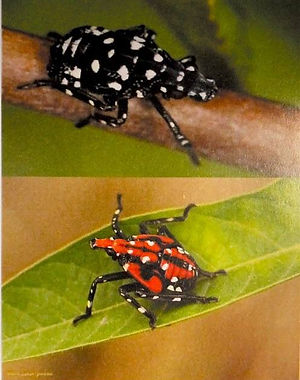
Spotted Lanternfly
The Spotted Lanternfly is an invasive insect from Asia that threatens important agricultural commodities.
This planthopper weakens plants by feeding on sap. It excretes a sticky, sugary substance called honeydew which attracts stinging insects, promotes the growth of sooty mold, and causes a messy nuisance for residents.
Know What to Look For:
Nymph Stage

Nymphs are 1/4" to 1/2" long and develop through four stages, all of which are wingless. Early stage nymphs can be found late April through July, while late stage nymphs appear July through September
Adult Stage

Spotted lanternfly adults are about 1" long and 1/2" wide with wings folded. They can be found July through December
Egg Mass

Egg masses have a gray, mud-like covering which can become dry and cracked over time. Older egg masses may lose their covering and appear as columns of 30-50 seed-like eggs. Egg masses can be found on trees, rocks, and other hard surfaces from September through June
Some of the more prevalent host species for this insect include:
Staghorn Sumac
(Rhus typhina)

-
Toothed leaf edge
-
Upright red, fuzzy fruit
-
Twigs are fuzzy
-
Smooth bark
-
Horizontal lenticels on bark
-
Grows in clonal colonies
Tree of Heaven
(Ailanthus altissima)

-
Primary host
-
Smooth leaf edge
-
1-2 teeth at leaf base
-
Strong odor (burnt peanut butter)
-
V or heart-shaped leaf scar
-
No terminal bud
-
Papery seed
-
Light gray/brown bark
-
Cantaloupe bark pattern
Black Walnut
(Juglans nigra)

-
Toothed leaf edge
-
Large round fruit
-
"Monkey-faced" leaf scar
-
Chambered dark pith
-
Dark, rough diamond pattern bark
